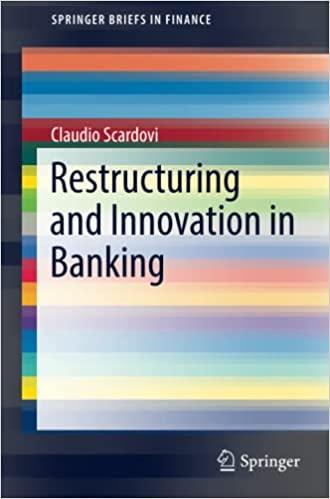Question
Are my answers correct? Suppose you invest $10,000 in a savings account earning 2% interest (compounded yearly) with no risk. After 7 years, how much
Are my answers correct?
Suppose you invest $10,000 in a savings account earning 2% interest (compounded yearly) with no risk. After 7 years, how much will you have?
Principal = $10,000.00
Rate = 2.00%
Year = 7
Amount (Compound interest) = P x (1 + r/n) ^nt
Where P = Principal
r rate of interest
n = number of time interest is calculated in a year
t = time
Amount after 7 years = 10,000 x (1+0.02) ^7 = $11,486.86
Repeat Question #1, but this time there is an inflation rate of 4%. How does this change your overall return on investment? If you had a chance to invest in an account with a long-term expected rate of 5%, with a 50% chance of earning 0% nominal compound interest and a 50% chance of earning 10% nominal compound interest in each year, would you choose this account, or the savings account? Why?
Effects of inflation on PV = 10,000 x (1/(1+0.04)^7) = $7,599.18
FV Adjusted for inflation = 11,486.86 x (1/(1+0.04)^7) = $ 8,729.07
Overall return on investment will decrease by 1,270.93 = 10,000 8,729.07
Repeat #1 with inflation:
Amount after 7 years = 10,000 x ((1+0.02)/(1+0.04)) ^7
10,000 x (0.98) ^7 = $8,729.07.
Safe vs. Risky (not including inflation)
If I get 0%, the amount after 7 years = 10,000 x (1+0.00) ^7 = $10,000.00
If I get 10%, the amount after 7 years = 10,000 x (1+0.10) ^7 = $19,487.17
If I get 5% (expected), amount after 7 years = 10,000 x (1+0.05) ^7 = $14,071.00
I would choose the account with the 5% expected rate of return because it has higher effective annual return over the saving account. There is a higher return, but the risk is higher as compared to the savings account, which provides a certain return.
Suppose you will need $50,000 in 4 years to start up a new business you have planned. With a 5% real interest rate, how much do you have to invest now in order to achieve this goal?
This condition clearly says that we need to calculate the present value of the future earnings and it has to be the present value factor and not annuity.
Therefore, to get 50000 is the future value therefore present value of 50000
Amount to be invested today =PVF@5%,4 *Amount
= .82270 * 50000
= $ 41135.12
Repeat Problem #3, but assume you can contribute an equal amount on a yearly basis. How much would you need to put into the account each year?
Amount to invested each year = Amount /FVAF@5%,4 = 11,600.66
Step by Step Solution
There are 3 Steps involved in it
Step: 1

Get Instant Access to Expert-Tailored Solutions
See step-by-step solutions with expert insights and AI powered tools for academic success
Step: 2

Step: 3

Ace Your Homework with AI
Get the answers you need in no time with our AI-driven, step-by-step assistance
Get Started


